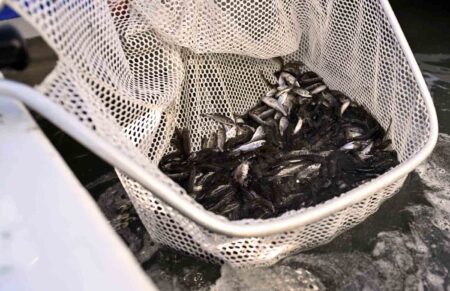Across Florida there are signs that spring has sprung, from the fine layer of yellow pollen coating everything in the north to folks returning to the water sans wetsuit in the south. Warmer water also means the return of Spanish mackerel, a feisty fish that migrates south when the water temperature dips below 70 and should be returning to north Florida waters right about now.
Spanish mackerel are easy to catch, making them a great target for kids and those new to the sport, but their aggressive fighting behavior when on the line also makes them exciting for seasoned veterans.
Interested in catching a Spanish mackerel or two? Spring and early summer are a great time to target these fish as they move north along the coast. They frequent nearshore sandy and grassy areas, from bays to beaches and piers, but can also be caught farther offshore. Spanish mackerel typically follow baitfish, so look for areas where fish are jumping.
The main two ways to target Spanish mackerel are trolling for them (running a line behind your boat while it is in motion) and casting.
When it comes to gear, the goal is to replicate baitfish.
If you are trolling for them, many people use what is called a mackerel tree, a series of hooks on a line with pieces of tubing acting as lures near each hook followed by a trolling spoon.
If you plan to fish for Spanish mackerel by casting, then spoons, jigs or any shallow diving lure will work. Spanish mackerel are a fairly fragile fish that need to be handled carefully and quickly when catching and releasing. If your artificial lures have treble hooks on them, consider bending down all the barbs or replacing the treble hooks with single hooks. Treble hooks can cause significant damage to a fish.
Unlike some species, Spanish mackerel will go after a wide variety of artificial lures, but if you are a natural-bait fan, try threadfin herring, cigar minnows or finger-sized mullet.
Mackerel have extremely sharp teeth. So if you don’t want to lose your lure and your line, make sure to use a leader that is at least 30 pound test. Above that, a good light spinning rod with 10- to 15-pound test will be plenty to reel in the fish.
Whether or not you ever hit the daily bag limit of 15 Spanish mackerel per person in state waters, there are plenty of other fish nearby to target, such as bluefish and lady fish, which also follow bait around.
Be sure to keep a measuring device nearby. The minimum size limit for Spanish mackerel is 12 inches fork length, which is measured from the tip of the lower jaw with the mouth closed to the center of the fork in the tail. Be sure to use a straight line measurement and not a flexible tape, as this can throw off your measurement.
Size limits and bag limits help ensure the Spanish mackerel population remains sustainable for future generations. The first statewide daily bag limit was set in 1986 and was four fish per person. This was increased to five in 1991, to 10 in 1993 and to where it is today, 15, in 2000. The size limit went into effect in 1999.
Find a keeper or two? Spanish mackerel are best eaten fresh, not frozen, within the first three days of being caught. Make sure to ice them down good and keep them cold. They can be grilled, fried, baked or smoked.
Catch a really big one? The current state record is 12 pounds, caught off Fort Pierce in 1984, and the world record is 13 pounds caught in North Carolina in 1987. If you think you can beat that, visit the International Game Fish Association website at IGFA.org or, for state records, visit MyFWC.com/Fishing and click on “Saltwater” and “Grand Slam/Fishing Records.”
Learn more about Spanish mackerel at MyFWC.com/Fishing by clicking on “Saltwater,” “Recreational Regulations” and “Mackerel, Spanish.” Email comments, questions, photos or suggestions to Saltwater@MyFWC.com.
Don’t forget to record all of your catches on the iAngler phone app or atsnookfoundation.org.
“Gone Coastal” is one of many ways that the Florida Fish and Wildlife Conservation Commission (FWC) Division of Marine Fisheries Management is helping recreational anglers understand complex saltwater regulations and learn more about saltwater fishing opportunities and issues in Florida. We are also available to answer questions by phone or email anytime, and we would love the opportunity to share information through in-person presentations with recreational or commercial fishing organizations. To contact the FWC’s Regulatory Outreach subsection, call 850-487-0554 or email Saltwater@MyFWC.com.
April 2014 “Gone Coastal” article by Amanda Nalley
myfwc.com
Enjoy fishing, hunting, hiking, kayaking and other outdoor sports and activities? Take a look at our OUTDOORS section, updated regularly with interesting and insightful articles.



